|
Vegetable Identification of Radish and Spinach Seedlings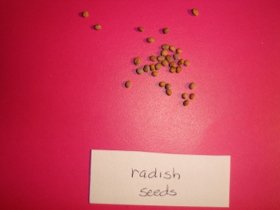
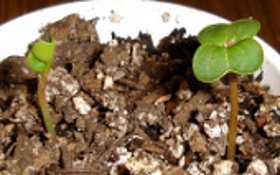
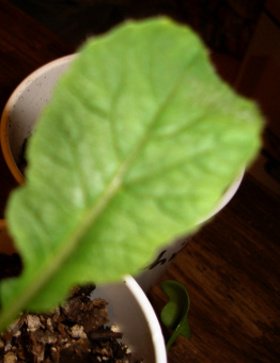
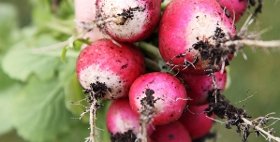
The radish is a fast growing and fast maturing crop. It has the best taste and texture if it is grown in loose soil with consistent moisture. Since it is ready in 3-4 weeks, it should be checked daily after 3 weeks. The round seeds need loose soil to develop good texture. Plant them about 1/3-1/2 inch deep, as early as 3 weeks before the last frost date. They will germinate within 3-10 days, provided the soil temperature is over 50 degrees. You can use a cold frame to achieve this temperature if it's still chilly. Space them about an inch apart and thin to 3 inches, or space them 2 inches apart and harvest those that reach grape size while allowing the others to grow larger. Radishes grow best below 75 degrees, and can tolerate a light frost. They are best sown as an early spring or late fall crop. To keep a ready supply, it's a good idea to stagger the sowing every 10 days or so. Once the temperatures reach 75 degrees farenheit, wait until about 8 weeks before your first frost date to sow them again. When harvesting radishes, cool them off in cold water and remove the leaves and roots before you refrigerate them. They can last up to 3 weeks in the refrigerator if kept in an airtight container. You can usually see the top of the root breaking above the soil when they've reached good size. Generally, hot weather will cause radishes to become spicy and often crack. Lack of consistent water will also cause cracking. There are types that will take heat a little better, usually the white carrot-type rooted kind. You can find them in many colors, including pink, white, red, and purple. Radishes are well adapted to intensive gardening and container gardening, requiring just 6 or more hours of light per day. Use balanced fertilizer, as too much nitrogen will cause great leaf growth at the expense of an edible root. Open pollinated varieties like Cherry Belle will bolt when temperatures rise and send up a stalk for flowering. Allow several plants to ripen the seed pods. When they have dried and turned brown you can pick them. Crumble the pods in your hands and save the seed. Blowing on the dry pieces of pod (outdoors) will winnow out most of the debris. Spinach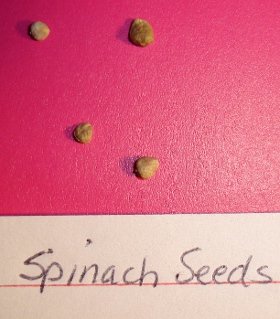
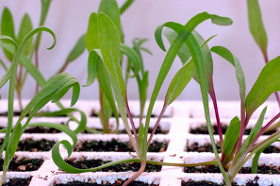
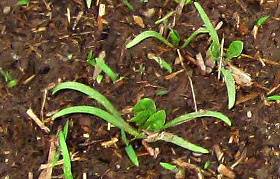
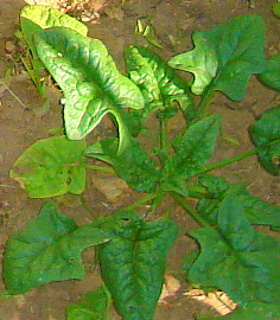
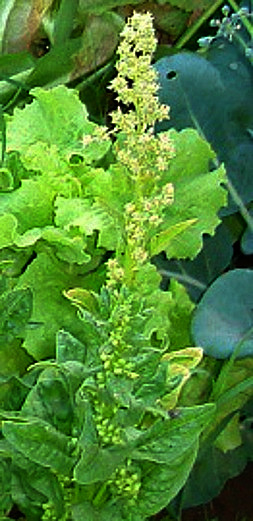
Spinach should be the earliest crop sown in spring, and will not germinate if the soil is too warm. It loves cool weather, withstands frost, and bolts into flower if the days become long and warm. If you wish to produce seeds from an open pollinated variety, you should keep a block of plants and allow them to go to seed. There will be male and female plants, and pollination is accomplished by wind. Once the seeds have formed, keep the female plants and allow the seed to ripen.
There are flat leaf types and savoy or crinkle leaf types. The flat leaf are easier to clean, but a bit more perishable. Spinach leaves should be harvested between 3-6 inchesin length, either by removing large leaves from several plants, or harvesting individual rosettes by cutting them off at ground level. If planted in fall, you leave it growing until the first hard frost is predicted. In mild climates, a little protection during winter will keep it alive, and it will start growing again in spring. Spinach does not like very acid or very alkaline soil, preferring 6.0-6.5 ph range. Plant seeds 1/4-1/2 inch deep, 3 inches apart. Space rows about 12 inches apart. Keep evenly moist in loose, well drained soil. Swiss Chard and Beets are relatives of spinach, so do not plant it in the same area these were grown the year before, as they are subject to many of the same diseases and pests.
from Vegetable Identification back to Vegetable Plant Identification from Vegetable Identification to Vegetable Gardening Advice Home |





